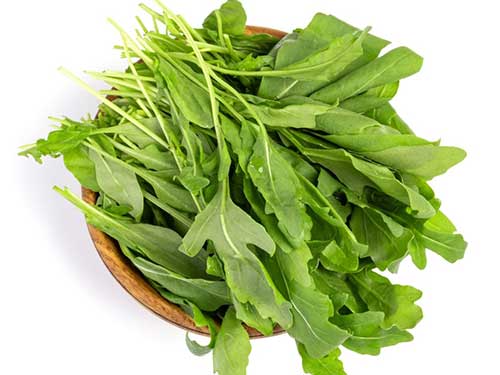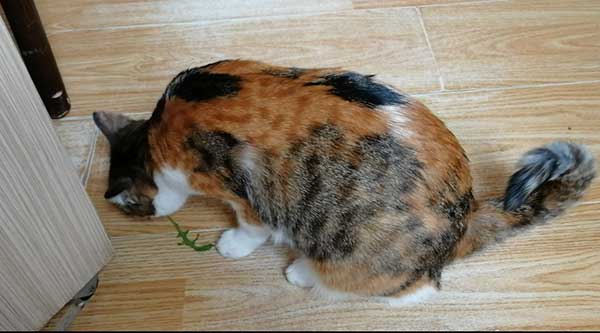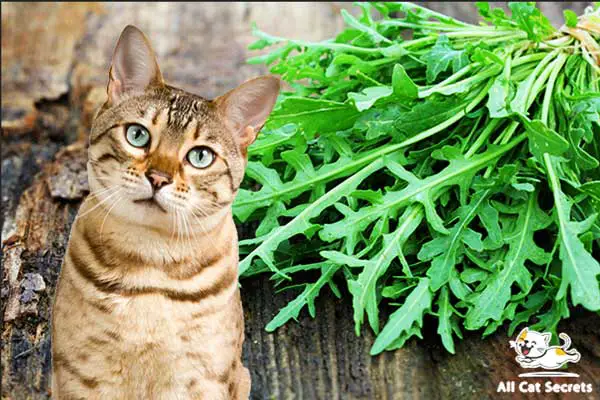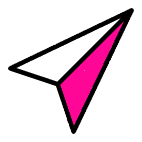It’s not unusual to come across a cat frantically meowing for human foods. Neither is it unusual to find a pet parent readily sharing people foods with their feline companions.
But if you’ve owned a cat long enough, you’ve probably already profiled the specific foods that the animal can eat and what he shouldn’t.
Experts generally discourage sharing most human foods with our feline friends. That’s especially true for plant-based foods prepared using a considerable amount of salt, spices, and/or fats. However, does that rule also apply to arugula? Can cats eat arugula?
The short answer is yes, cats can safely eat arugula. Despite its slightly bitter and spicy taste, arugula isn’t immediately toxic to cats. In fact, this plant contains scores of mineral elements and vitamins that your feline friend can benefit from.
If you’ve always wondered to yourself, ‘can cats have arugula,’ it’s reassuring to note that you can share arugula with your kitto without worrying about the animal developing immediate health concerns. But as with any plant-based product, arugula is only safe and beneficial to cats if served in moderation.
Whatever you do, arugula must never replace your cat’s regular pet-approved diet. That’s for the simple reason that cats are obligate carnivores and require only a negligible amount of greens in their diet.
Read on for more insights into arugula and cats. The post shall cover, among other things, the potential health benefits and risks of arugula for cats.
Table of Contents
More About Arugula
Arugula is an edible annual plant in the Brassicaceae or Cruciferous family noted for its distinctive peppery taste that oscillates between spicy and bitter.
The plant is native to the Mediterranean region, covering vast stretches between Morocco and Portugal. It goes by numerous other names, such as rocket, garden rocket, ruchetta, rugula, rucoli, rucola, eruca, colewort, roquette, and Italian cress.

a. Physical Description
Arugula plants can grow to a height of 20 to 100 centimeters (8 to 40 inches). The plant sports deeply lobed pinnate leaves. Each leaf has between four and ten lateral lobes, as well as one large terminal lobe.
When in bloom, arugula produces beautiful flower blossoms that measure 2 to 4 centimeters in diameter. The flowers feature creamy white petals which purple veins and yellow stamens.
b. Application
Arugula is widely used in various cuisines around the world. The plant is loaded with just about the same nutritional elements you’d find in most vegetables of the cruciferous family, such as kales, cauliflowers, broccoli, Brussels sprouts, etc.
As a staple ingredient in many recipes, arugula is mainly added to salads or used to garnish various foods like pizza and pasta. The vegetable may also be cooked and consumed as a standalone meal. Some people also prefer serving it with a sauce of lemon juice and virgin oil.
Now that you’re well-acquainted with what arugula is, you may now be wondering, is arugula good for my cat?
As we’ve already mentioned, arugula is not only safe for cats. The vegetable also packs numerous mineral elements and vitamins that cats can enjoy. In fact, most vegetables in the cruciferous family are deemed safe and beneficial for cats.
The following section highlights some of the potential health benefits of sharing arugula with your feline friend.
Arugula Benefits for Cats
100 grams (about 3.5 ounces) of raw arugula contains the following nutritional elements;
- Energy – 105 kilojoules (25 kilocalories)
- Carbohydrates – 3.6 grams
- Sugars – 2.0 grams
- Protein – 2.6 grams
- Dietary fiber – 1.6 grams
- Fat – 0.6 grams
- Water – 91.7 g
- Vitamin A – 15% of the recommended daily intake (RDI)
- Vitamin B1 – 4% of the RDI
- Vitamin B2 – 7% of the RDI
- Vitamin B3 – 2% of the RDI
- Vitamin B6 – 6% of the RDI
- Vitamin B9 – 24% of the RDI
- Vitamin C – 18% of the RDI
- Vitamin E – 3% of the RDI
- Vitamin K – 10% of the RDI
- Sodium – 2% of the RDI
- Copper – 4% of the RDI
- Zinc – 5% of the RDI
- Phosphorus – 7% of the RDI
- Potassium – 8% of the RDI
- Iron – 11% of the RDI
- Magnesium – 13% of the RDI
- Manganese – 15% of the RDI
- Calcium – 16% of the RDI
Outlined below are the specific health benefits that your cat can enjoy from snacking on arugula, based on the above nutritional profile;
1. Aiding Digestion
Like most vegetables in the cruciferous family, arugula is rich in dietary fiber. Fiber is noted for its incredible role in aiding digestion.
Arugula is loaded with both soluble and insoluble fiber.
Soluble fiber is so named due to its ability to dissolve readily into the bloodstream. This fiber has been shown to nourish gut microbiota – the microorganisms that live throughout an animal’s alimentary canal.
On the other hand, insoluble fiber moves through the stomach undigested. In the process, it adds bulk to a cat’s stool, thereby accelerating the animal’s bowel movements. The insoluble fiber in arugula may help to relieve digestive disorders like constipation.
2. Weight Management
One of the most effective natural ways to keep your cat’s weight in check is by monitoring the food portions that the animal consumes in one sitting.
Fortunately, arugula abounds in three elements known to support weight management – dietary fiber, protein, and water. These compounds mainly combat weight gain by inducing a sense of fullness faster, while also maintaining those sensations for longer.
So, if you’re worried that your cat is packing up a few extra pounds, supplementing with arugula may help keep the animal’s weight in check.
- WEIGHT MANAGEMENT SUPPORT: Featuring cat food dry with Alaskan pollock, this low-calorie recipe assists with weight control,...
- GRAIN-FREE NUTRITION: This grain-free cat food recipe provides a nutritious and gluten-free diet, boosting your cat's overall...
- HOLISTIC PET FOOD SINCE 1974: Trust Solid Gold cat food as your healthy cat food choice, crafted with superfoods, probiotics, and...
Last update on 2025-03-09 / Affiliate links / Images from Amazon Product Advertising API
3. Managing Dehydration
Water is an essential requirement for all living organisms, our feline friends included. But cats are notorious for being picky eaters and drinkers.
Since cats are meant to be playful, they should drink plenty of water to replenish the fluids lost during playtime. That’s where water-rich foods like arugula come in.
An average serving of raw arugula contains as much as 90% water. Adding this vegetable to your cat’s food is an ingenious way of helping the animal achieve his daily recommended water intake.
4. Maintaining Healthy Teeth and Bones
A toothless cat is as good as dead. Without teeth, a cat will not be able to fend off other feline intruders.
The same applies to cats with fragile bones. Weaker bones increases a cat’s susceptibility to physical injury.
Any responsible pet parent would appreciate the importance of feeding their cats foods loaded in calcium. It’s reassuring to know that arugula is rich in this mineral.
Besides promoting healthier bones and teeth, calcium may also aid muscle and nerve function.
View this post on Instagram
5. Aiding Vision
Arugula is packed with vitamin A compounds, including fat-soluble retinoids. Studies have shown that retinoids can improve vision.
The compound has particularly been cited for its ability to enhance night vision while also guarding against eye conditions like macular degeneration.
6. Keeping Disease at Bay
Rocket lettuce, like its other cousins in the cruciferous family, is high in antioxidants like vitamin C.
Also known as ascorbic acid, vitamin C boosts tissue health, accelerates the absorption of iron from food, and improves overall immunity.
Arugula’s antioxidant properties are also attributed to vitamin A.
In addition to boosting your cat’s vision, vitamin A may also help to maintain the animal’s vital organs like the heart, lung, and kidney. Vitamin A also works synergistically with vitamin C to keep disease at bay.
The following are other essential minerals in arugula, along with the roles they could play in your cat’s body;
Vitamin K – Accelerates the body’s blood clotting processes.
Potassium – Maintains electrolyte balance while also aiding muscle contraction.
Folate – Supports the synthesis of DNA and other genetic materials, which makes it a particular recommendation for expecting cats.
So, is it okay for cats to eat arugula?
Having gone through a couple of health benefits of arugula for cats, it’s logical to infer that the vegetable is good for cats. But before you proceed to share arugula with your little furball, it would help to understand some of the side effects to expect. The next section sheds more light on that.
Possible Issues With Arugula for Cats
Arugula is fundamentally a plant-based food. That mere fact makes it potentially risky for cats.
Remember, cats are obligate carnivores. As such, they require a diet made predominantly of lean meat.
It’s undeniably true that cats can snack on plant-based foods occasionally. But too many greens in your kitto’s diet could induce a host of gastrointestinal issues. That’s especially if consuming these products for the first time. Some of the side effects of arugula for cats include nausea, vomiting, diarrhea, and abdominal discomfort.
Maybe you’ve always wondered, is arugula bad for my cat?
Well, arugula can be problematic for your cat if fed in excess. And the situation can only get worse if introducing this vegetable to your kitto for the first time.
Allergic reactions are another potential issue with arugula for cats. Again, this ties back to the fact that a cat’s digestive tract isn’t designed primarily for processing plant-based foods.
Symptoms of arugula allergy may vary significantly from one cat to another. But most cats will exhibit signs of stomach upset, such as vomiting and diarrhea.
View this post on Instagram
Last but not least, it’s worth noting that arugula contains an excess of certain minerals and vitamins. A notable example is vitamin A. Overexposure to this vitamin could have fatal consequences.
The fiber content in arugula may also prove harmful to your cat.
Small amounts of dietary fiber could aid your cat’s digestion by nourishing gut microbiota and bulking up the animal’s stool. However, excess amounts could produce a laxative effect, inducing bouts of diarrhea. Without timely interventions, diarrhea could lead to dehydration and eventually a coma.
While humans can enjoy an abundance of these minerals, the amounts contained in arugula may prove way too much for your feline friend.
Is arugula poisonous to cats?
Arugula isn’t immediately poisonous to cats. The vegetable doesn’t contain any toxins that could injury your feline friend. However, arugula can induce a series of side effects if fed to cats in excess. And the situation could be devastating for cats snacking on this vegetable for the first time.
How Can I Feed My Cat Arugula?
So far, this post has managed to demystify the question ‘is arugula safe for cats?’ We’ve seen that arugula is not only safe but also beneficial to cats if served in moderation. That said, it’s important to understand the best way to prepare arugula for your kitto.
Now, arugula can be served to cats raw or cooked. Each option has its pros and drawbacks.

Raw arugula has all the nutritional elements intact. However, raw vegetables are known to harbor harmful pathogens, such as Salmonella and E. coli.
Therefore, your best bet is to cook arugula before serving it to your cat. Experts recommend boiling or steaming the vegetable.
However, don’t overcook arugula as that could destroy the vitamins and mineral elements in the vegetable. Also, avoid adding salts, spices, or fats as these ingredients could prove toxic to your cat.
Once the food is done, you can serve it to your cat as a standalone snack or mix it into his regular food.
Other Frequently Asked Questions About Cats and Arugula
Can cats eat baby arugula?
Baby arugula is nearly as safe for cats as mature arugula. However, the younger plant may not contain an abundance of the essential mineral elements in fully-grown arugula plants.
How often can I give my cat arugula?
There’s really no hard-and-fast rule on how often you can share arugula with your cat. The conventional wisdom is to feed the vegetable to your kitto in moderation. Arugula should never replace your cat’s regular diet.
- Food supplement for everyday use. Supports cell protection and strengthens your cat’s adaptive immune system with important...
- Organically bound trace elements zinc, manganese and selenium. DL-methionine for a well-balanced metabolism, taurine for vitality...
- Supports cats of every age, older cats and kitten. Long-term or short-term treatment for skin and fur troubles like hair loss,...
Last update on 2025-03-10 / Affiliate links / Images from Amazon Product Advertising API
Can kittens eat arugula?
Kittens tend to have a more sensitive stomach than adult cats. While arugula may not trigger immediate risks to kittens, you should probably not feed this vegetable to them. If you must give your kitten arugula, allow for a couple of months after the kitten has been weaned.
Can my cat eat arugula?
Again, your cat can eat arugula but only in moderation.
Is Arugula Ok For Cats?
Arugula is one of the many vegetables considered safe and relatively nutritious for cats. The vegetable packs nutrients that cats may benefit from, including fiber, protein, B-vitamins, and antioxidants.
But as with any plant-based foods, the cardinal rule is to feed arugula to your cat in moderation.
Checkout Our Favorite Cat Products
1. Best Online Course For Cat Parents
Our favorite: The Cat Language Bible (How to Finally Understand And Speak to Your Cat) – A new form of cat to human communication that many cat owners have dreamed about… but few have actually thought possible.
2. Best Immune Support For Cats
Our favorite: Tomlyn Immune Support – Best Supplement for Cats and Kittens.
3. Best Cat Treats
Our favorites: LIFE ESSENTIALS All Natural Freeze Dried Chicken And Sheba Meaty Tender Sticks – Both are Great.






